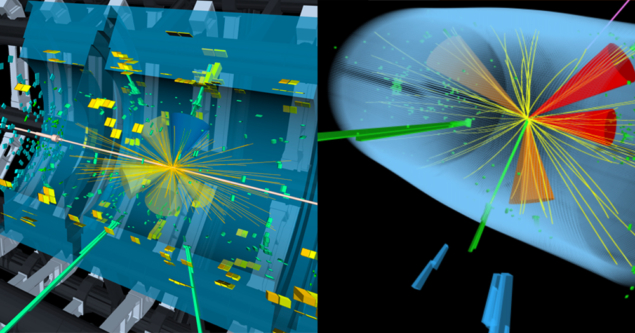
One of the many doors to new physics that have been opened by the discovery of the Higgs boson concerns the possibility of finding charge-parity violation (CPV) in Higgs-boson interactions. Were CPV to be observed in the Higgs sector, it would be an unambiguous indication of physics beyond the Standard Model (SM), and could have important ramifications for understanding the baryon asymmetry of the universe. Recently, the ATLAS and CMS collaborations reported their first forays into this area by measuring the CP-structure of interactions between the Higgs boson and top quarks.
While CPV is well established in the weak interactions of quarks (most recently in the charm system by the LHCb collaboration), and is explained in the SM by the existence of a phase in the CKM matrix, the amount of CPV observed is many orders of magnitude too small to account for the observed cosmological matter-antimatter imbalance. Searching for additional sources of CPV is a major programme in particle physics, with a moderate-significance suggestion of CPV in lepton interactions recently announced by the T2K collaboration. It is likely that sources of CPV from phenomena beyond the scope of the SM are needed, and the detailed properties of the Higgs sector are one of several possible hiding places.
Based on the full LHC Run 2 dataset, ATLAS and CMS studied events where the Higgs boson is produced in association with one or two top quarks before decaying into two photons. The latter (ttH) process, which accounts for around 1% of the Higgs bosons produced at the LHC, was observed by both collaborations in 2018. But the tH production channel is predicted to be about six times rarer. This is due to destructive interference between higher order diagrams involving W bosons, and makes the tH process particularly sensitive to new-physics processes.
Exploring the CP properties of these interactions is non-trivial
According to the SM, the Higgs boson is “CP-even” – that is, it is possible to rotate-away any CP-odd phase from the scalar mass term. Previous probes of the interaction between the Higgs and vector bosons by CMS and ATLAS support the CP-even nature of the Higgs boson, determining its quantum numbers to be most consistent with JPC = 0++, though small CP-odd contributions from a more complex coupling structure are not excluded. The presence of a CP-odd component, together with the dominant CP-even one, would imply CPV, altering the kinematic properties of the ttH process and modifying tH production. Exploring the CP properties of these interactions is non-trivial, and requires the full capacities of the detectors and analysis techniques.
The collaborations employed machine-learning (Boosted Decision Tree) algorithms to disentangle the relative fractions of the CP-even and CP-odd components of top-Higgs interactions. The CMS collaboration observed ttH production at significance of 6.6σ, and excluded a pure CP-odd structure of the top-Higgs Yukawa coupling at 3.2σ. The ratio of the measured ttH production rate to the predicted production rate was found by CMS to be 1.38 with an uncertainty of about 25%. ATLAS data also show agreement with the SM. Assuming a CP-even coupling, ATLAS observed ttH with a significance of 5.2σ. Comparing the strength of the CP-even and CP-odd components, the collaboration favours a CP-mixing angle very close to 0 (indicating no CPV) and excludes a pure CP-odd coupling at 3.9σ. ATLAS did not observe tH production, setting an upper limit on its rate of 12 times the SM expectation.
In addition to further probing the CP properties of the top–Higgs interaction with larger data samples, ATLAS and CMS are searching in other Higgs-boson interactions for signs of CPV.
Further reading
ATLAS Collab. 2020 arXiv:2004.04545.
CMS Collab. 2020 arXiv:2003.10866.







